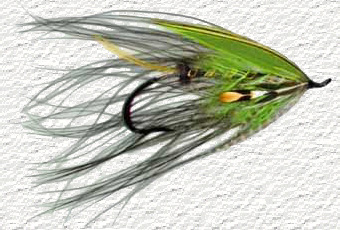

| Hook= Any long shank, light wire salmon/steelhead model | Sample fly is on an Alec Jackson #1 1/2 |
| Thread= Black | 6/0-12/0 |
| Tag= Fine silver tinsel | Oval tinsel is stronger than flat, & adds a bit more flash |
| Tail= G.P.crest | Crests are often referred to as "toppings" in the old tying books |
| Butt= Black dyed ostrich herl | 2 turns only, to hide the tie-offs of the tag & tail. Avoid leaving excess material forward of the butt; it will make a "lumpy" body |
| Body= Black silk floss | Floss is tied in at the front, & wound towards the butt; binding down the ribbing tinsel. Reverse direction, & tie in the hackle tip with the floss. This tie in should be at the point where the 2nd or 3rd turn of ribbing crosses under the body |
| Ribs= Flat & fine oval gold tinsel | 5 or 6 turns, with the oval butting against the trailing edge of the flat |
| Hackle= Imitation heron belly, dyed loden green | Use a permanant marker to blacken the tips of a green dyed maribou hackle. Strip one side, & wrap immediately behind the tinsel rib |
| Throat= Teal flank | Tied in by the tip, "doubled", & wrap 2 or 3 turns |
| Wing= Goose strips dyed loden green, with narrow strip of yellow over narrow strip of black married to top edge | Reversing the thread will prevent the far wing from collapsing. The yellow strip replaces a topping, which was used in the original Ranger type wing. The black strip replaces the bars in the original's tippet wing. |
| Cheeks= Jungle cock | Set drooping |